Public Services: NHS Development, Structure, Funding, and Roles
VerifiedAdded on 2021/02/19
|17
|5396
|37
Report
AI Summary
This report provides a comprehensive analysis of public services, with a specific focus on the development and organizational structure of the National Health Service (NHS). It begins by defining public services and exploring their evolution, highlighting key aspects such as public administration and the various services provided, including healthcare, education, and emergency services. The report then delves into the history of the NHS, tracing its development from its inception in 1948, detailing significant milestones and changes across different decades, and addressing the challenges faced. A key section focuses on the NHS's hierarchical organizational structure, examining its advantages, such as control and specialization, and disadvantages, such as restricted information flow. The report also explores the sources of funding for public sector organizations and how funding is allocated, and concludes with an overview of the strategies, structure, and roles within the public sector. This report, contributed by a student, offers valuable insights into the NHS and public service management.

PUBLIC SERVIC
Paraphrase This Document
Need a fresh take? Get an instant paraphrase of this document with our AI Paraphraser
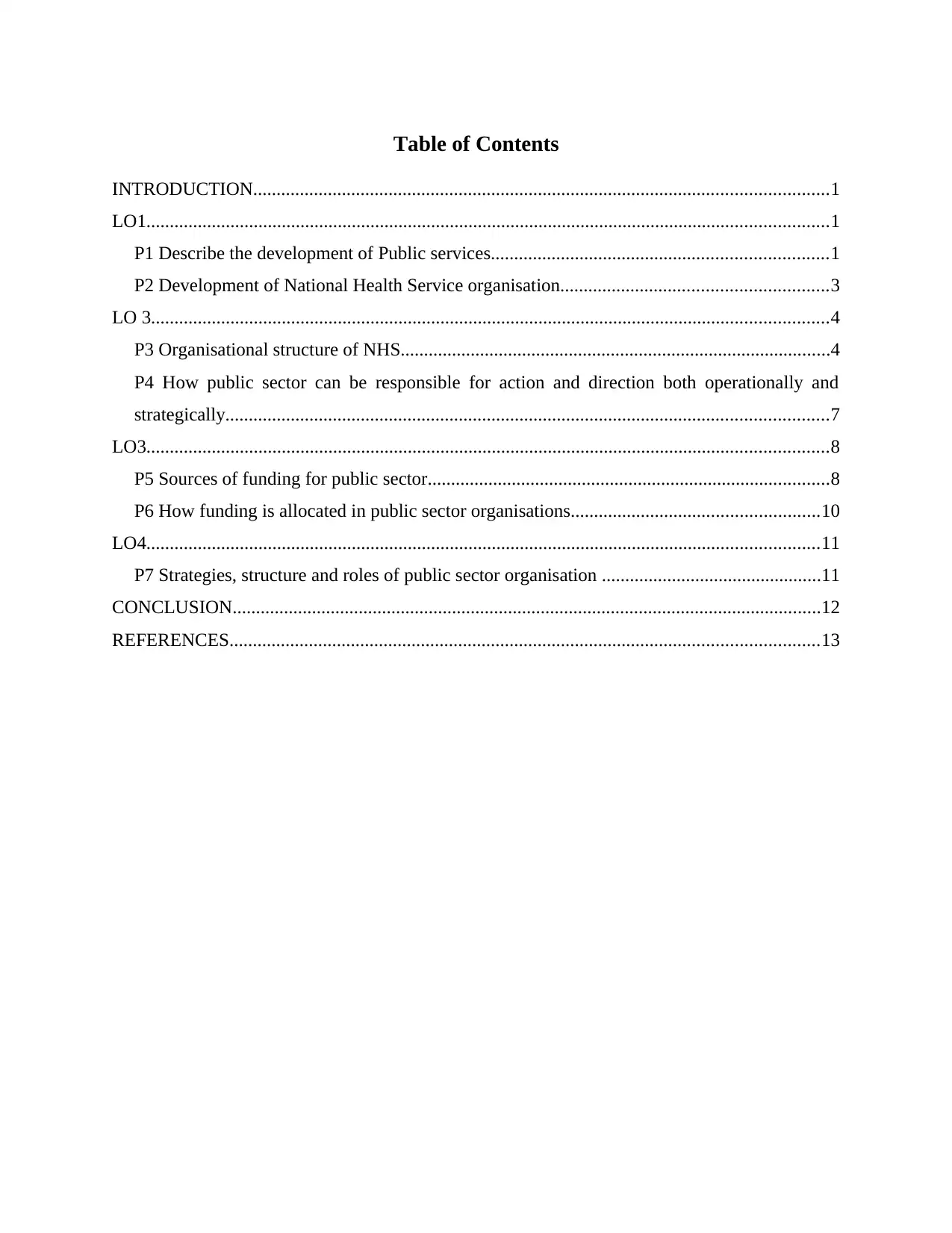
Table of Contents
INTRODUCTION...........................................................................................................................1
LO1..................................................................................................................................................1
P1 Describe the development of Public services........................................................................1
P2 Development of National Health Service organisation.........................................................3
LO 3.................................................................................................................................................4
P3 Organisational structure of NHS............................................................................................4
P4 How public sector can be responsible for action and direction both operationally and
strategically.................................................................................................................................7
LO3..................................................................................................................................................8
P5 Sources of funding for public sector......................................................................................8
P6 How funding is allocated in public sector organisations.....................................................10
LO4................................................................................................................................................11
P7 Strategies, structure and roles of public sector organisation ...............................................11
CONCLUSION..............................................................................................................................12
REFERENCES..............................................................................................................................13
INTRODUCTION...........................................................................................................................1
LO1..................................................................................................................................................1
P1 Describe the development of Public services........................................................................1
P2 Development of National Health Service organisation.........................................................3
LO 3.................................................................................................................................................4
P3 Organisational structure of NHS............................................................................................4
P4 How public sector can be responsible for action and direction both operationally and
strategically.................................................................................................................................7
LO3..................................................................................................................................................8
P5 Sources of funding for public sector......................................................................................8
P6 How funding is allocated in public sector organisations.....................................................10
LO4................................................................................................................................................11
P7 Strategies, structure and roles of public sector organisation ...............................................11
CONCLUSION..............................................................................................................................12
REFERENCES..............................................................................................................................13
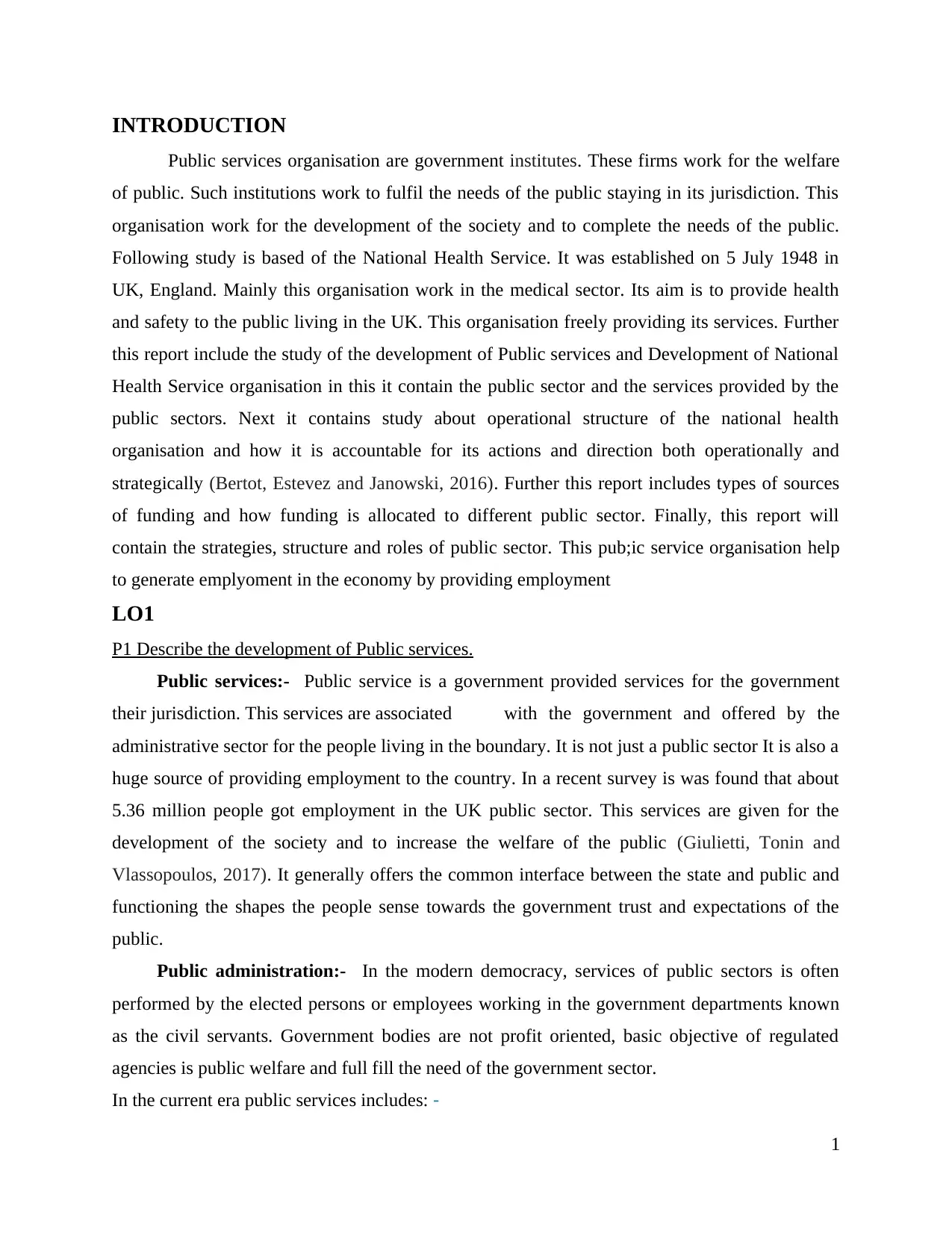
INTRODUCTION
Public services organisation are government institutes. These firms work for the welfare
of public. Such institutions work to fulfil the needs of the public staying in its jurisdiction. This
organisation work for the development of the society and to complete the needs of the public.
Following study is based of the National Health Service. It was established on 5 July 1948 in
UK, England. Mainly this organisation work in the medical sector. Its aim is to provide health
and safety to the public living in the UK. This organisation freely providing its services. Further
this report include the study of the development of Public services and Development of National
Health Service organisation in this it contain the public sector and the services provided by the
public sectors. Next it contains study about operational structure of the national health
organisation and how it is accountable for its actions and direction both operationally and
strategically (Bertot, Estevez and Janowski, 2016). Further this report includes types of sources
of funding and how funding is allocated to different public sector. Finally, this report will
contain the strategies, structure and roles of public sector. This pub;ic service organisation help
to generate emplyoment in the economy by providing employment
LO1
P1 Describe the development of Public services.
Public services:- Public service is a government provided services for the government
their jurisdiction. This services are associated with the government and offered by the
administrative sector for the people living in the boundary. It is not just a public sector It is also a
huge source of providing employment to the country. In a recent survey is was found that about
5.36 million people got employment in the UK public sector. This services are given for the
development of the society and to increase the welfare of the public (Giulietti, Tonin and
Vlassopoulos, 2017). It generally offers the common interface between the state and public and
functioning the shapes the people sense towards the government trust and expectations of the
public.
Public administration:- In the modern democracy, services of public sectors is often
performed by the elected persons or employees working in the government departments known
as the civil servants. Government bodies are not profit oriented, basic objective of regulated
agencies is public welfare and full fill the need of the government sector.
In the current era public services includes: -
1
Public services organisation are government institutes. These firms work for the welfare
of public. Such institutions work to fulfil the needs of the public staying in its jurisdiction. This
organisation work for the development of the society and to complete the needs of the public.
Following study is based of the National Health Service. It was established on 5 July 1948 in
UK, England. Mainly this organisation work in the medical sector. Its aim is to provide health
and safety to the public living in the UK. This organisation freely providing its services. Further
this report include the study of the development of Public services and Development of National
Health Service organisation in this it contain the public sector and the services provided by the
public sectors. Next it contains study about operational structure of the national health
organisation and how it is accountable for its actions and direction both operationally and
strategically (Bertot, Estevez and Janowski, 2016). Further this report includes types of sources
of funding and how funding is allocated to different public sector. Finally, this report will
contain the strategies, structure and roles of public sector. This pub;ic service organisation help
to generate emplyoment in the economy by providing employment
LO1
P1 Describe the development of Public services.
Public services:- Public service is a government provided services for the government
their jurisdiction. This services are associated with the government and offered by the
administrative sector for the people living in the boundary. It is not just a public sector It is also a
huge source of providing employment to the country. In a recent survey is was found that about
5.36 million people got employment in the UK public sector. This services are given for the
development of the society and to increase the welfare of the public (Giulietti, Tonin and
Vlassopoulos, 2017). It generally offers the common interface between the state and public and
functioning the shapes the people sense towards the government trust and expectations of the
public.
Public administration:- In the modern democracy, services of public sectors is often
performed by the elected persons or employees working in the government departments known
as the civil servants. Government bodies are not profit oriented, basic objective of regulated
agencies is public welfare and full fill the need of the government sector.
In the current era public services includes: -
1
You're viewing a preview
Unlock full access by subscribing today!
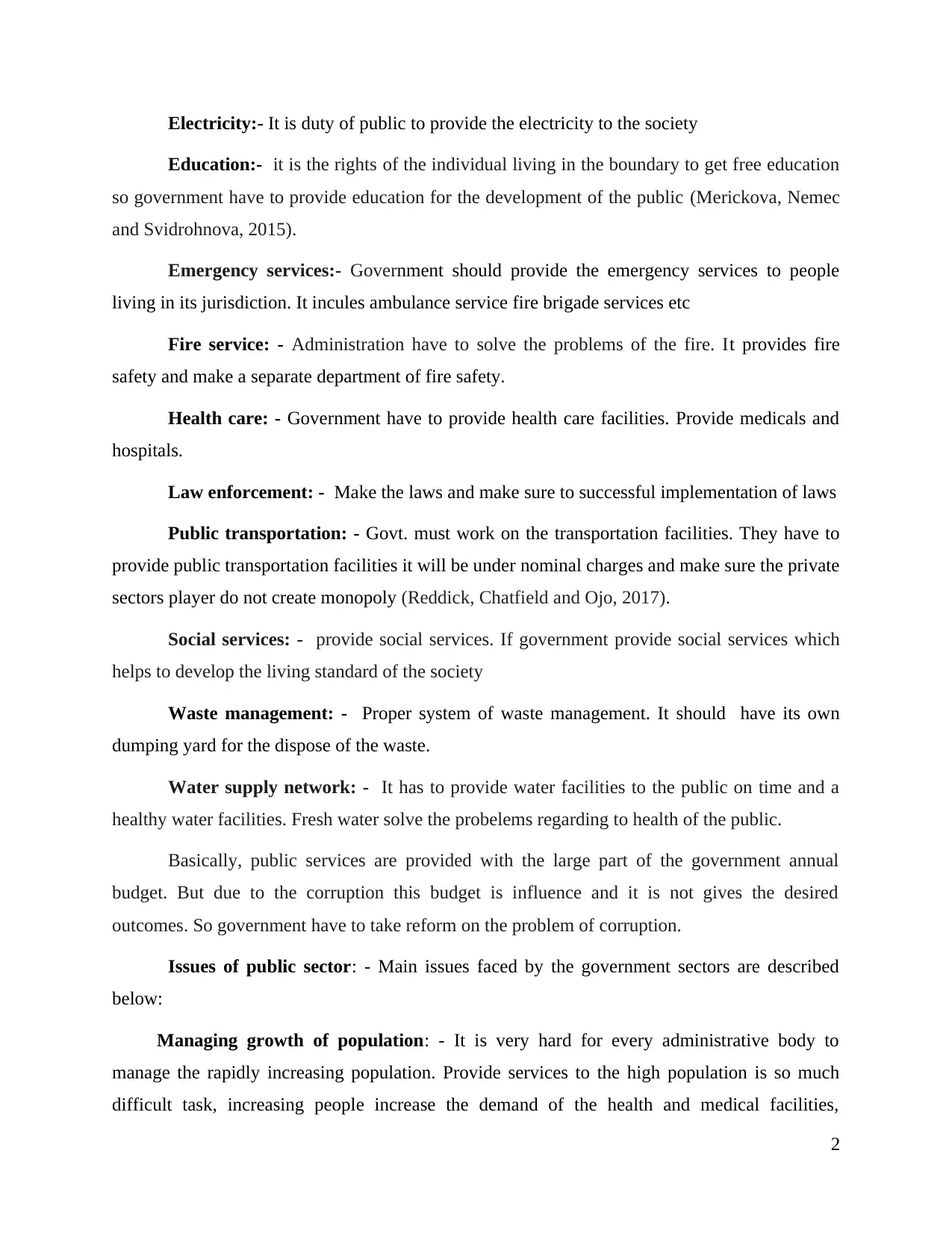
Electricity:- It is duty of public to provide the electricity to the society
Education:- it is the rights of the individual living in the boundary to get free education
so government have to provide education for the development of the public (Merickova, Nemec
and Svidrohnova, 2015).
Emergency services:- Government should provide the emergency services to people
living in its jurisdiction. It incules ambulance service fire brigade services etc
Fire service: - Administration have to solve the problems of the fire. It provides fire
safety and make a separate department of fire safety.
Health care: - Government have to provide health care facilities. Provide medicals and
hospitals.
Law enforcement: - Make the laws and make sure to successful implementation of laws
Public transportation: - Govt. must work on the transportation facilities. They have to
provide public transportation facilities it will be under nominal charges and make sure the private
sectors player do not create monopoly (Reddick, Chatfield and Ojo, 2017).
Social services: - provide social services. If government provide social services which
helps to develop the living standard of the society
Waste management: - Proper system of waste management. It should have its own
dumping yard for the dispose of the waste.
Water supply network: - It has to provide water facilities to the public on time and a
healthy water facilities. Fresh water solve the probelems regarding to health of the public.
Basically, public services are provided with the large part of the government annual
budget. But due to the corruption this budget is influence and it is not gives the desired
outcomes. So government have to take reform on the problem of corruption.
Issues of public sector: - Main issues faced by the government sectors are described
below:
Managing growth of population: - It is very hard for every administrative body to
manage the rapidly increasing population. Provide services to the high population is so much
difficult task, increasing people increase the demand of the health and medical facilities,
2
Education:- it is the rights of the individual living in the boundary to get free education
so government have to provide education for the development of the public (Merickova, Nemec
and Svidrohnova, 2015).
Emergency services:- Government should provide the emergency services to people
living in its jurisdiction. It incules ambulance service fire brigade services etc
Fire service: - Administration have to solve the problems of the fire. It provides fire
safety and make a separate department of fire safety.
Health care: - Government have to provide health care facilities. Provide medicals and
hospitals.
Law enforcement: - Make the laws and make sure to successful implementation of laws
Public transportation: - Govt. must work on the transportation facilities. They have to
provide public transportation facilities it will be under nominal charges and make sure the private
sectors player do not create monopoly (Reddick, Chatfield and Ojo, 2017).
Social services: - provide social services. If government provide social services which
helps to develop the living standard of the society
Waste management: - Proper system of waste management. It should have its own
dumping yard for the dispose of the waste.
Water supply network: - It has to provide water facilities to the public on time and a
healthy water facilities. Fresh water solve the probelems regarding to health of the public.
Basically, public services are provided with the large part of the government annual
budget. But due to the corruption this budget is influence and it is not gives the desired
outcomes. So government have to take reform on the problem of corruption.
Issues of public sector: - Main issues faced by the government sectors are described
below:
Managing growth of population: - It is very hard for every administrative body to
manage the rapidly increasing population. Provide services to the high population is so much
difficult task, increasing people increase the demand of the health and medical facilities,
2
Paraphrase This Document
Need a fresh take? Get an instant paraphrase of this document with our AI Paraphraser
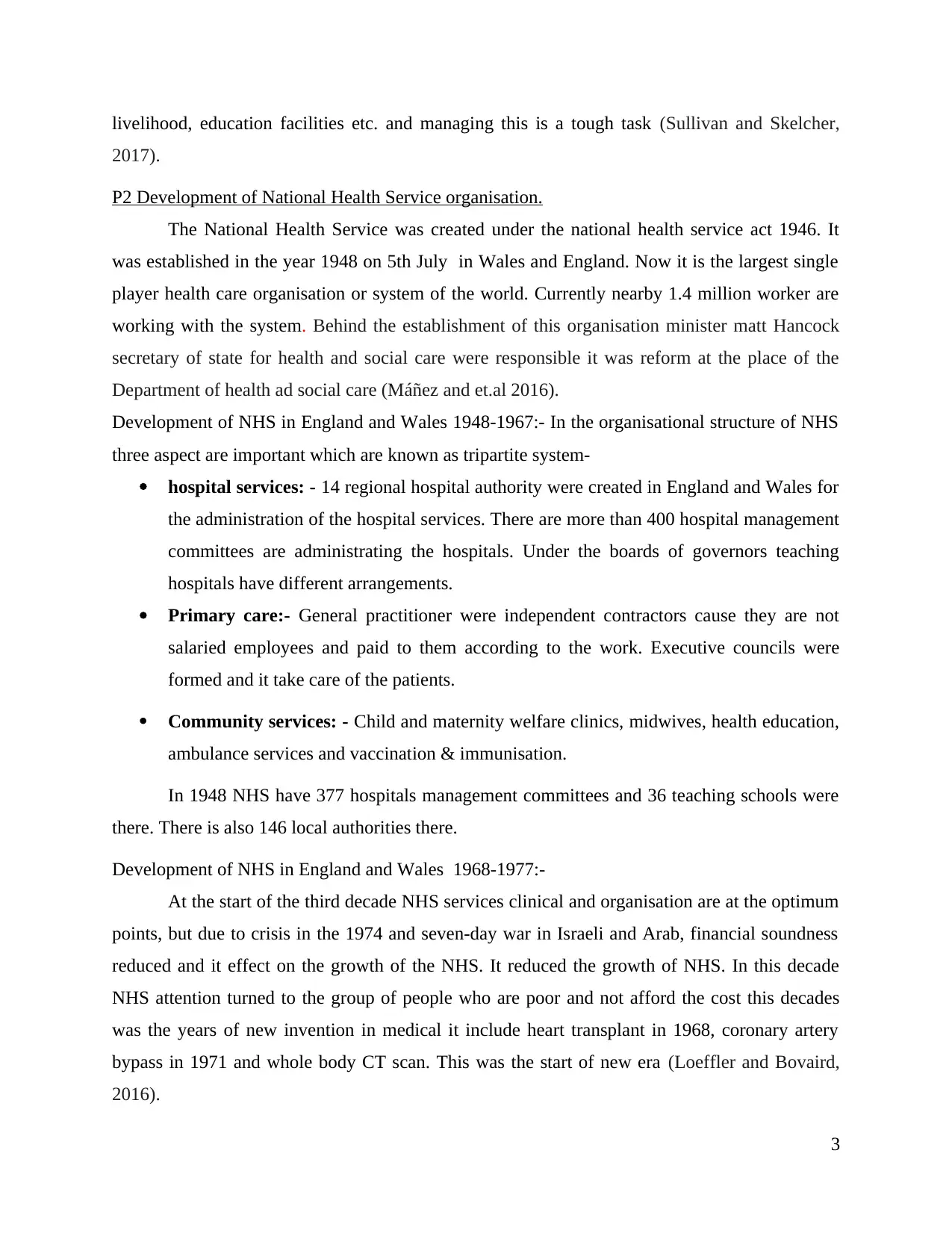
livelihood, education facilities etc. and managing this is a tough task (Sullivan and Skelcher,
2017).
P2 Development of National Health Service organisation.
The National Health Service was created under the national health service act 1946. It
was established in the year 1948 on 5th July in Wales and England. Now it is the largest single
player health care organisation or system of the world. Currently nearby 1.4 million worker are
working with the system. Behind the establishment of this organisation minister matt Hancock
secretary of state for health and social care were responsible it was reform at the place of the
Department of health ad social care (Máñez and et.al 2016).
Development of NHS in England and Wales 1948-1967:- In the organisational structure of NHS
three aspect are important which are known as tripartite system-
hospital services: - 14 regional hospital authority were created in England and Wales for
the administration of the hospital services. There are more than 400 hospital management
committees are administrating the hospitals. Under the boards of governors teaching
hospitals have different arrangements.
Primary care:- General practitioner were independent contractors cause they are not
salaried employees and paid to them according to the work. Executive councils were
formed and it take care of the patients.
Community services: - Child and maternity welfare clinics, midwives, health education,
ambulance services and vaccination & immunisation.
In 1948 NHS have 377 hospitals management committees and 36 teaching schools were
there. There is also 146 local authorities there.
Development of NHS in England and Wales 1968-1977:-
At the start of the third decade NHS services clinical and organisation are at the optimum
points, but due to crisis in the 1974 and seven-day war in Israeli and Arab, financial soundness
reduced and it effect on the growth of the NHS. It reduced the growth of NHS. In this decade
NHS attention turned to the group of people who are poor and not afford the cost this decades
was the years of new invention in medical it include heart transplant in 1968, coronary artery
bypass in 1971 and whole body CT scan. This was the start of new era (Loeffler and Bovaird,
2016).
3
2017).
P2 Development of National Health Service organisation.
The National Health Service was created under the national health service act 1946. It
was established in the year 1948 on 5th July in Wales and England. Now it is the largest single
player health care organisation or system of the world. Currently nearby 1.4 million worker are
working with the system. Behind the establishment of this organisation minister matt Hancock
secretary of state for health and social care were responsible it was reform at the place of the
Department of health ad social care (Máñez and et.al 2016).
Development of NHS in England and Wales 1948-1967:- In the organisational structure of NHS
three aspect are important which are known as tripartite system-
hospital services: - 14 regional hospital authority were created in England and Wales for
the administration of the hospital services. There are more than 400 hospital management
committees are administrating the hospitals. Under the boards of governors teaching
hospitals have different arrangements.
Primary care:- General practitioner were independent contractors cause they are not
salaried employees and paid to them according to the work. Executive councils were
formed and it take care of the patients.
Community services: - Child and maternity welfare clinics, midwives, health education,
ambulance services and vaccination & immunisation.
In 1948 NHS have 377 hospitals management committees and 36 teaching schools were
there. There is also 146 local authorities there.
Development of NHS in England and Wales 1968-1977:-
At the start of the third decade NHS services clinical and organisation are at the optimum
points, but due to crisis in the 1974 and seven-day war in Israeli and Arab, financial soundness
reduced and it effect on the growth of the NHS. It reduced the growth of NHS. In this decade
NHS attention turned to the group of people who are poor and not afford the cost this decades
was the years of new invention in medical it include heart transplant in 1968, coronary artery
bypass in 1971 and whole body CT scan. This was the start of new era (Loeffler and Bovaird,
2016).
3
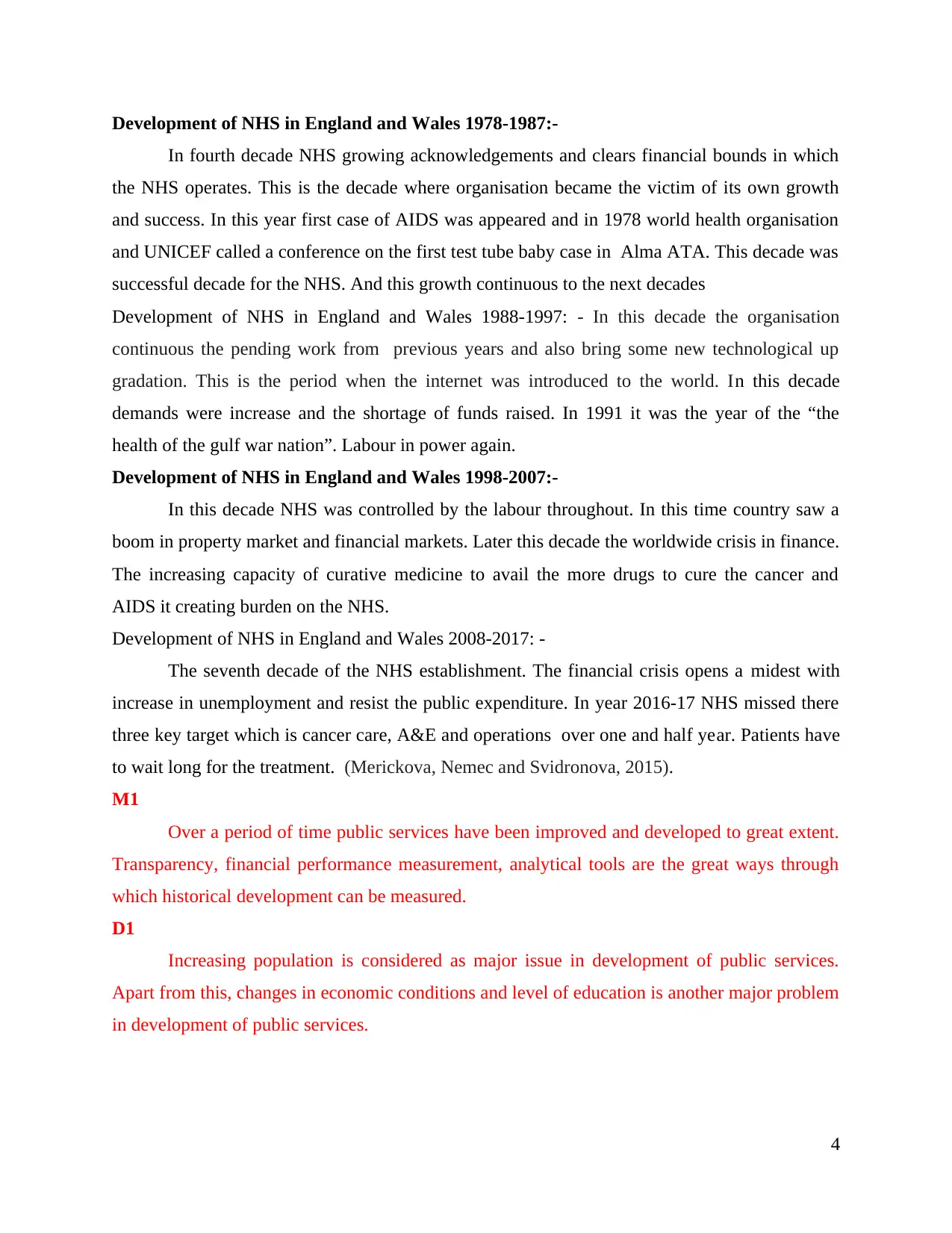
Development of NHS in England and Wales 1978-1987:-
In fourth decade NHS growing acknowledgements and clears financial bounds in which
the NHS operates. This is the decade where organisation became the victim of its own growth
and success. In this year first case of AIDS was appeared and in 1978 world health organisation
and UNICEF called a conference on the first test tube baby case in Alma ATA. This decade was
successful decade for the NHS. And this growth continuous to the next decades
Development of NHS in England and Wales 1988-1997: - In this decade the organisation
continuous the pending work from previous years and also bring some new technological up
gradation. This is the period when the internet was introduced to the world. In this decade
demands were increase and the shortage of funds raised. In 1991 it was the year of the “the
health of the gulf war nation”. Labour in power again.
Development of NHS in England and Wales 1998-2007:-
In this decade NHS was controlled by the labour throughout. In this time country saw a
boom in property market and financial markets. Later this decade the worldwide crisis in finance.
The increasing capacity of curative medicine to avail the more drugs to cure the cancer and
AIDS it creating burden on the NHS.
Development of NHS in England and Wales 2008-2017: -
The seventh decade of the NHS establishment. The financial crisis opens a midest with
increase in unemployment and resist the public expenditure. In year 2016-17 NHS missed there
three key target which is cancer care, A&E and operations over one and half year. Patients have
to wait long for the treatment. (Merickova, Nemec and Svidronova, 2015).
M1
Over a period of time public services have been improved and developed to great extent.
Transparency, financial performance measurement, analytical tools are the great ways through
which historical development can be measured.
D1
Increasing population is considered as major issue in development of public services.
Apart from this, changes in economic conditions and level of education is another major problem
in development of public services.
4
In fourth decade NHS growing acknowledgements and clears financial bounds in which
the NHS operates. This is the decade where organisation became the victim of its own growth
and success. In this year first case of AIDS was appeared and in 1978 world health organisation
and UNICEF called a conference on the first test tube baby case in Alma ATA. This decade was
successful decade for the NHS. And this growth continuous to the next decades
Development of NHS in England and Wales 1988-1997: - In this decade the organisation
continuous the pending work from previous years and also bring some new technological up
gradation. This is the period when the internet was introduced to the world. In this decade
demands were increase and the shortage of funds raised. In 1991 it was the year of the “the
health of the gulf war nation”. Labour in power again.
Development of NHS in England and Wales 1998-2007:-
In this decade NHS was controlled by the labour throughout. In this time country saw a
boom in property market and financial markets. Later this decade the worldwide crisis in finance.
The increasing capacity of curative medicine to avail the more drugs to cure the cancer and
AIDS it creating burden on the NHS.
Development of NHS in England and Wales 2008-2017: -
The seventh decade of the NHS establishment. The financial crisis opens a midest with
increase in unemployment and resist the public expenditure. In year 2016-17 NHS missed there
three key target which is cancer care, A&E and operations over one and half year. Patients have
to wait long for the treatment. (Merickova, Nemec and Svidronova, 2015).
M1
Over a period of time public services have been improved and developed to great extent.
Transparency, financial performance measurement, analytical tools are the great ways through
which historical development can be measured.
D1
Increasing population is considered as major issue in development of public services.
Apart from this, changes in economic conditions and level of education is another major problem
in development of public services.
4
You're viewing a preview
Unlock full access by subscribing today!
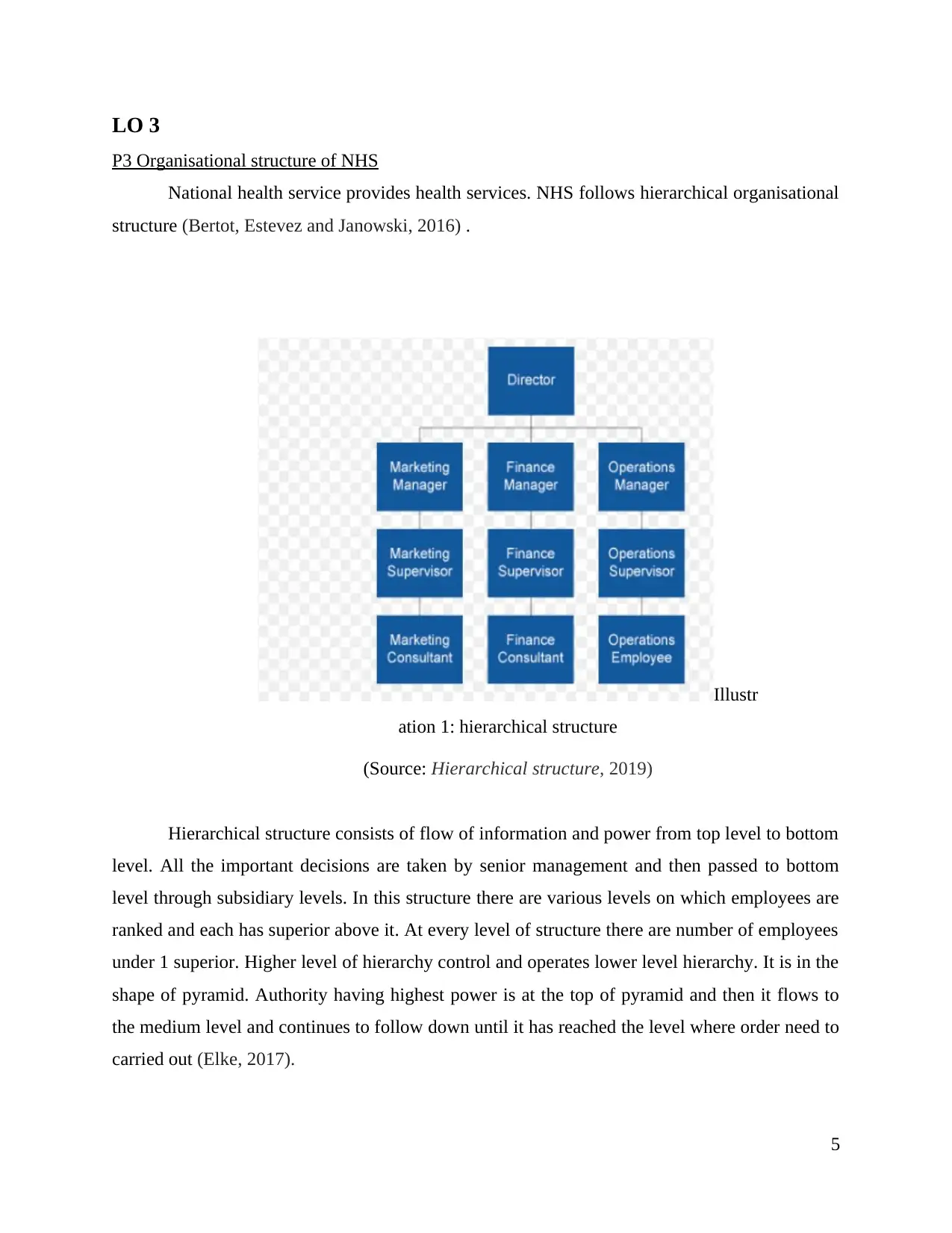
LO 3
P3 Organisational structure of NHS
National health service provides health services. NHS follows hierarchical organisational
structure (Bertot, Estevez and Janowski, 2016) .
Hierarchical structure consists of flow of information and power from top level to bottom
level. All the important decisions are taken by senior management and then passed to bottom
level through subsidiary levels. In this structure there are various levels on which employees are
ranked and each has superior above it. At every level of structure there are number of employees
under 1 superior. Higher level of hierarchy control and operates lower level hierarchy. It is in the
shape of pyramid. Authority having highest power is at the top of pyramid and then it flows to
the medium level and continues to follow down until it has reached the level where order need to
carried out (Elke, 2017).
5
Illustr
ation 1: hierarchical structure
(Source: Hierarchical structure, 2019)
P3 Organisational structure of NHS
National health service provides health services. NHS follows hierarchical organisational
structure (Bertot, Estevez and Janowski, 2016) .
Hierarchical structure consists of flow of information and power from top level to bottom
level. All the important decisions are taken by senior management and then passed to bottom
level through subsidiary levels. In this structure there are various levels on which employees are
ranked and each has superior above it. At every level of structure there are number of employees
under 1 superior. Higher level of hierarchy control and operates lower level hierarchy. It is in the
shape of pyramid. Authority having highest power is at the top of pyramid and then it flows to
the medium level and continues to follow down until it has reached the level where order need to
carried out (Elke, 2017).
5
Illustr
ation 1: hierarchical structure
(Source: Hierarchical structure, 2019)
Paraphrase This Document
Need a fresh take? Get an instant paraphrase of this document with our AI Paraphraser

Information flows vertically in this organisational structure. Information flows through
each level until it is reached to the top level. After information is reached to the top level, a
decision is made and transferred through different levels of management until it is reached the
level where it needs to be implemented. If a person at bottom level want to communicate or want
to make a decision, the information is communicated through a chain to the top level. Top level
management then communicate the answer through a chain to bottom level. In hierarchical
structure all the control and power is with top level so that quality of service and design can be
maintained. If top level management wants to communicate with bottom level than they will not
directly communicate with them but they will transfer the information through the levels of
management to the bottom level. It is beneficial for NHS to run the organisation smoothly
(Hierarchical structure, 2019.).
Advantages of hierarchical structure:
Control orientation: Companies who follows hierarchy structure have a better control
over the organisation. It is clearly defined that authority and responsibility is with the top
level of management. NHS is an independent body so it does not need to follow the
decision of the department of health.
6
Illustration 2: Hierarchical flow
each level until it is reached to the top level. After information is reached to the top level, a
decision is made and transferred through different levels of management until it is reached the
level where it needs to be implemented. If a person at bottom level want to communicate or want
to make a decision, the information is communicated through a chain to the top level. Top level
management then communicate the answer through a chain to bottom level. In hierarchical
structure all the control and power is with top level so that quality of service and design can be
maintained. If top level management wants to communicate with bottom level than they will not
directly communicate with them but they will transfer the information through the levels of
management to the bottom level. It is beneficial for NHS to run the organisation smoothly
(Hierarchical structure, 2019.).
Advantages of hierarchical structure:
Control orientation: Companies who follows hierarchy structure have a better control
over the organisation. It is clearly defined that authority and responsibility is with the top
level of management. NHS is an independent body so it does not need to follow the
decision of the department of health.
6
Illustration 2: Hierarchical flow
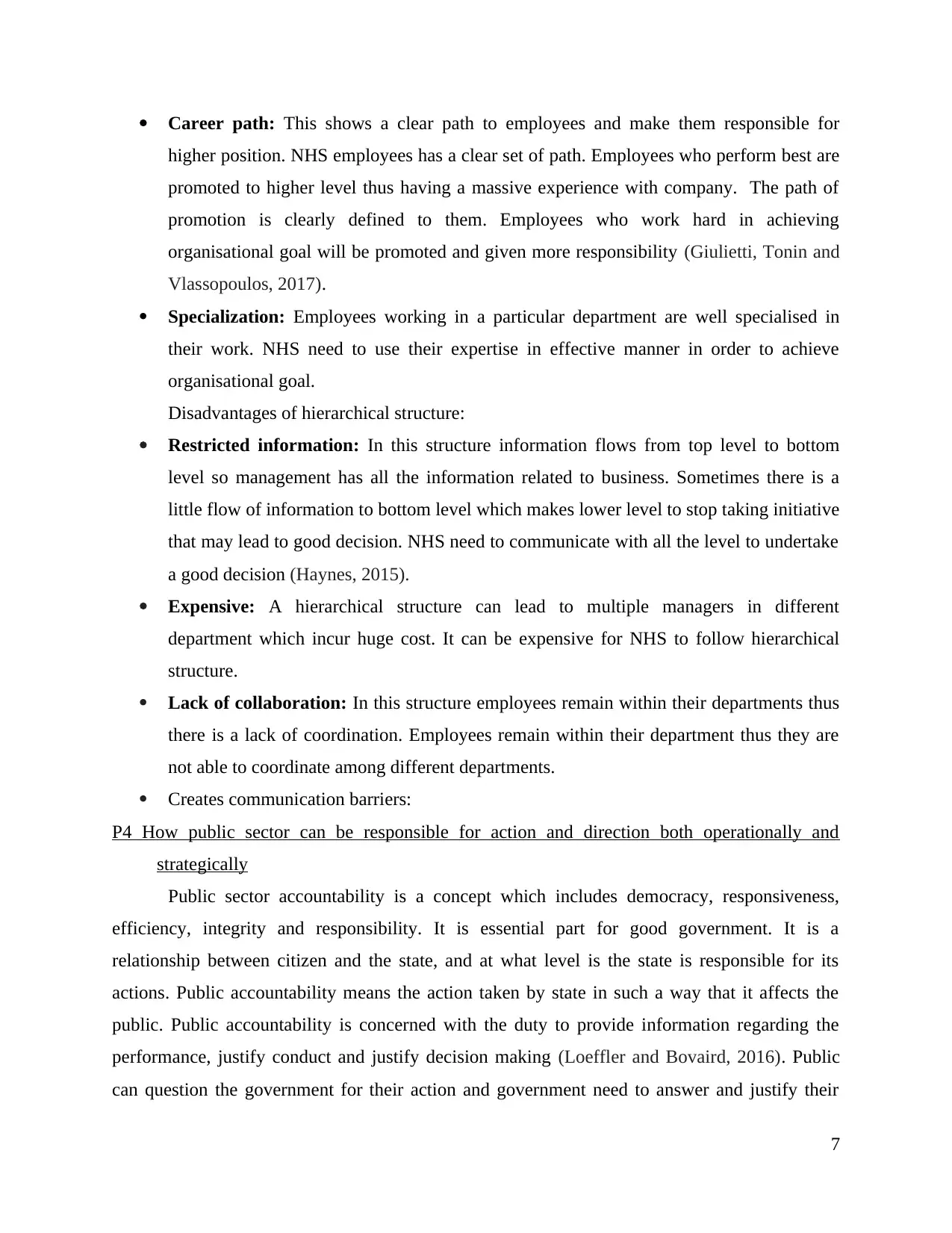
Career path: This shows a clear path to employees and make them responsible for
higher position. NHS employees has a clear set of path. Employees who perform best are
promoted to higher level thus having a massive experience with company. The path of
promotion is clearly defined to them. Employees who work hard in achieving
organisational goal will be promoted and given more responsibility (Giulietti, Tonin and
Vlassopoulos, 2017).
Specialization: Employees working in a particular department are well specialised in
their work. NHS need to use their expertise in effective manner in order to achieve
organisational goal.
Disadvantages of hierarchical structure:
Restricted information: In this structure information flows from top level to bottom
level so management has all the information related to business. Sometimes there is a
little flow of information to bottom level which makes lower level to stop taking initiative
that may lead to good decision. NHS need to communicate with all the level to undertake
a good decision (Haynes, 2015).
Expensive: A hierarchical structure can lead to multiple managers in different
department which incur huge cost. It can be expensive for NHS to follow hierarchical
structure.
Lack of collaboration: In this structure employees remain within their departments thus
there is a lack of coordination. Employees remain within their department thus they are
not able to coordinate among different departments.
Creates communication barriers:
P4 How public sector can be responsible for action and direction both operationally and
strategically
Public sector accountability is a concept which includes democracy, responsiveness,
efficiency, integrity and responsibility. It is essential part for good government. It is a
relationship between citizen and the state, and at what level is the state is responsible for its
actions. Public accountability means the action taken by state in such a way that it affects the
public. Public accountability is concerned with the duty to provide information regarding the
performance, justify conduct and justify decision making (Loeffler and Bovaird, 2016). Public
can question the government for their action and government need to answer and justify their
7
higher position. NHS employees has a clear set of path. Employees who perform best are
promoted to higher level thus having a massive experience with company. The path of
promotion is clearly defined to them. Employees who work hard in achieving
organisational goal will be promoted and given more responsibility (Giulietti, Tonin and
Vlassopoulos, 2017).
Specialization: Employees working in a particular department are well specialised in
their work. NHS need to use their expertise in effective manner in order to achieve
organisational goal.
Disadvantages of hierarchical structure:
Restricted information: In this structure information flows from top level to bottom
level so management has all the information related to business. Sometimes there is a
little flow of information to bottom level which makes lower level to stop taking initiative
that may lead to good decision. NHS need to communicate with all the level to undertake
a good decision (Haynes, 2015).
Expensive: A hierarchical structure can lead to multiple managers in different
department which incur huge cost. It can be expensive for NHS to follow hierarchical
structure.
Lack of collaboration: In this structure employees remain within their departments thus
there is a lack of coordination. Employees remain within their department thus they are
not able to coordinate among different departments.
Creates communication barriers:
P4 How public sector can be responsible for action and direction both operationally and
strategically
Public sector accountability is a concept which includes democracy, responsiveness,
efficiency, integrity and responsibility. It is essential part for good government. It is a
relationship between citizen and the state, and at what level is the state is responsible for its
actions. Public accountability means the action taken by state in such a way that it affects the
public. Public accountability is concerned with the duty to provide information regarding the
performance, justify conduct and justify decision making (Loeffler and Bovaird, 2016). Public
can question the government for their action and government need to answer and justify their
7
You're viewing a preview
Unlock full access by subscribing today!
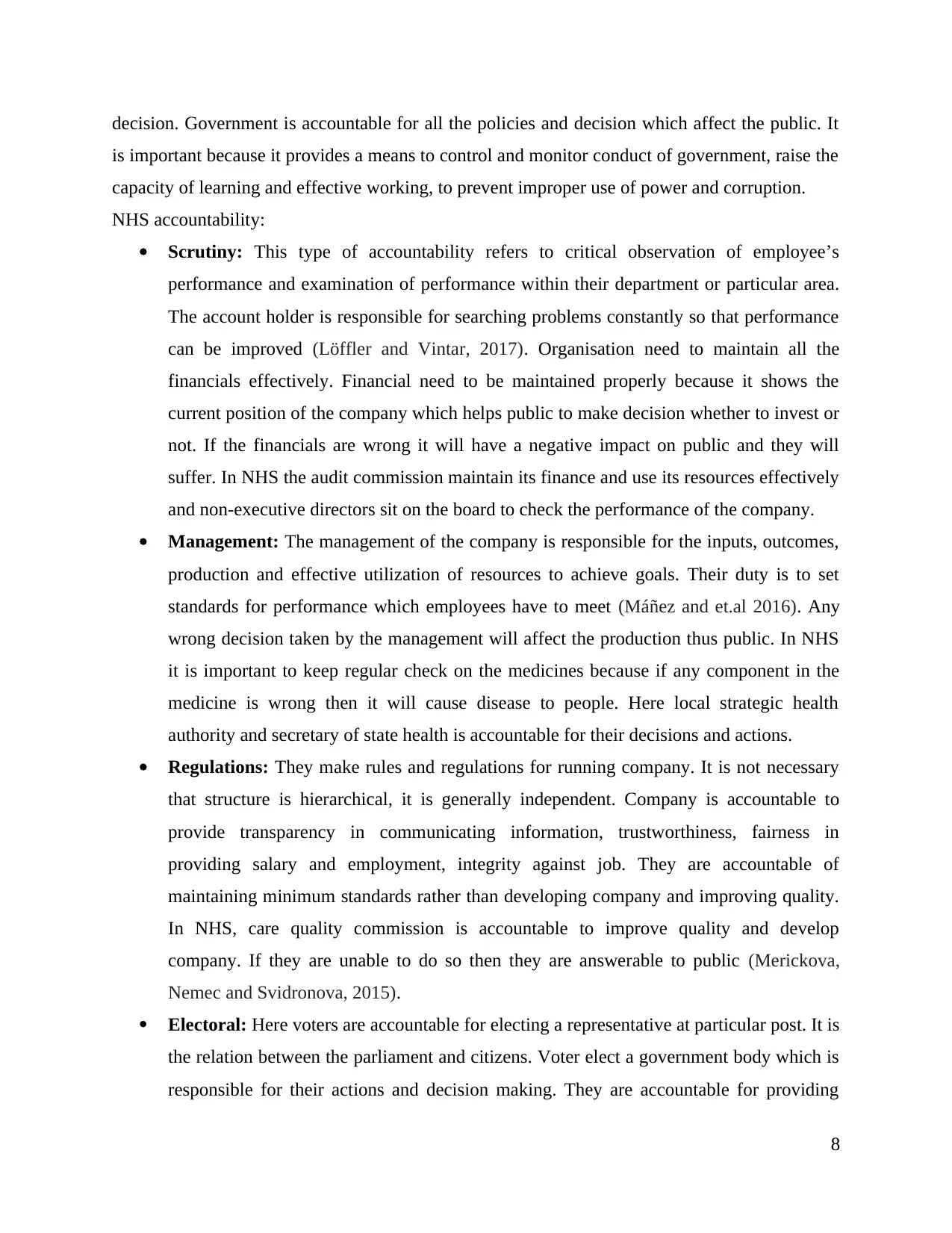
decision. Government is accountable for all the policies and decision which affect the public. It
is important because it provides a means to control and monitor conduct of government, raise the
capacity of learning and effective working, to prevent improper use of power and corruption.
NHS accountability:
Scrutiny: This type of accountability refers to critical observation of employee’s
performance and examination of performance within their department or particular area.
The account holder is responsible for searching problems constantly so that performance
can be improved (Löffler and Vintar, 2017). Organisation need to maintain all the
financials effectively. Financial need to be maintained properly because it shows the
current position of the company which helps public to make decision whether to invest or
not. If the financials are wrong it will have a negative impact on public and they will
suffer. In NHS the audit commission maintain its finance and use its resources effectively
and non-executive directors sit on the board to check the performance of the company.
Management: The management of the company is responsible for the inputs, outcomes,
production and effective utilization of resources to achieve goals. Their duty is to set
standards for performance which employees have to meet (Máñez and et.al 2016). Any
wrong decision taken by the management will affect the production thus public. In NHS
it is important to keep regular check on the medicines because if any component in the
medicine is wrong then it will cause disease to people. Here local strategic health
authority and secretary of state health is accountable for their decisions and actions.
Regulations: They make rules and regulations for running company. It is not necessary
that structure is hierarchical, it is generally independent. Company is accountable to
provide transparency in communicating information, trustworthiness, fairness in
providing salary and employment, integrity against job. They are accountable of
maintaining minimum standards rather than developing company and improving quality.
In NHS, care quality commission is accountable to improve quality and develop
company. If they are unable to do so then they are answerable to public (Merickova,
Nemec and Svidronova, 2015).
Electoral: Here voters are accountable for electing a representative at particular post. It is
the relation between the parliament and citizens. Voter elect a government body which is
responsible for their actions and decision making. They are accountable for providing
8
is important because it provides a means to control and monitor conduct of government, raise the
capacity of learning and effective working, to prevent improper use of power and corruption.
NHS accountability:
Scrutiny: This type of accountability refers to critical observation of employee’s
performance and examination of performance within their department or particular area.
The account holder is responsible for searching problems constantly so that performance
can be improved (Löffler and Vintar, 2017). Organisation need to maintain all the
financials effectively. Financial need to be maintained properly because it shows the
current position of the company which helps public to make decision whether to invest or
not. If the financials are wrong it will have a negative impact on public and they will
suffer. In NHS the audit commission maintain its finance and use its resources effectively
and non-executive directors sit on the board to check the performance of the company.
Management: The management of the company is responsible for the inputs, outcomes,
production and effective utilization of resources to achieve goals. Their duty is to set
standards for performance which employees have to meet (Máñez and et.al 2016). Any
wrong decision taken by the management will affect the production thus public. In NHS
it is important to keep regular check on the medicines because if any component in the
medicine is wrong then it will cause disease to people. Here local strategic health
authority and secretary of state health is accountable for their decisions and actions.
Regulations: They make rules and regulations for running company. It is not necessary
that structure is hierarchical, it is generally independent. Company is accountable to
provide transparency in communicating information, trustworthiness, fairness in
providing salary and employment, integrity against job. They are accountable of
maintaining minimum standards rather than developing company and improving quality.
In NHS, care quality commission is accountable to improve quality and develop
company. If they are unable to do so then they are answerable to public (Merickova,
Nemec and Svidronova, 2015).
Electoral: Here voters are accountable for electing a representative at particular post. It is
the relation between the parliament and citizens. Voter elect a government body which is
responsible for their actions and decision making. They are accountable for providing
8
Paraphrase This Document
Need a fresh take? Get an instant paraphrase of this document with our AI Paraphraser

information, knowledge, local needs and new technological changes etc. which is
beneficial for NHS to use these in their health care services.
M2
Structure of public sector is tall as government takes all the decisions for the respective
firm and these authorities are responsible for making sound judgement so that overall
development of country can be done. Funding, expansion, development decisions are taken by
these higher authorities and then it passes to next level of workers those who execute their
decisions.
LO3
P5 Sources of funding for public sector
Funding is a process of supplying financial resources generally in the money form or
other values such as equity and debts. Companies need funds to start their business. Sources of
funds include bank loan, venture capital, savings, donations, taxes and loans from financial
institution. Every business needs funds, no business can survive without funds, it is required
throughout the life of a business (Nucho, 2016). Companies want money to meet their needs i.e.
start-up of business, funds for regular business activities and to grow and expand business.
Usually there are 2 sources of funding Internal and External funds.
Internal funding:
Internal funds are raised from within the company. It refers to starting a company from
one's own money and not taking loan from bank. Company can use retained earnings, sale of
asset and revenues to expand or start their business.
Retained earnings: Companies make profits and keep aside a small part of profits as
retained earnings so that it can be used in business afterwards and distribute rest of the
profits. It is the amount which is left in the business after distributing dividends to
shareholders from net income (Pahl, 2016). Profits which is not distributed to
shareholders is called retained earnings. These earnings are used to reward shareholders
but it can also be invested to expand business and projects.
Sale of assets: When company cannot raise funds from the banks and other sources than
company sell their assets i.e. plant and machinery, land, cars etc. to raise money. It is
generally done when there is urgency of cash and there is no other source of financing.
External funding:
9
beneficial for NHS to use these in their health care services.
M2
Structure of public sector is tall as government takes all the decisions for the respective
firm and these authorities are responsible for making sound judgement so that overall
development of country can be done. Funding, expansion, development decisions are taken by
these higher authorities and then it passes to next level of workers those who execute their
decisions.
LO3
P5 Sources of funding for public sector
Funding is a process of supplying financial resources generally in the money form or
other values such as equity and debts. Companies need funds to start their business. Sources of
funds include bank loan, venture capital, savings, donations, taxes and loans from financial
institution. Every business needs funds, no business can survive without funds, it is required
throughout the life of a business (Nucho, 2016). Companies want money to meet their needs i.e.
start-up of business, funds for regular business activities and to grow and expand business.
Usually there are 2 sources of funding Internal and External funds.
Internal funding:
Internal funds are raised from within the company. It refers to starting a company from
one's own money and not taking loan from bank. Company can use retained earnings, sale of
asset and revenues to expand or start their business.
Retained earnings: Companies make profits and keep aside a small part of profits as
retained earnings so that it can be used in business afterwards and distribute rest of the
profits. It is the amount which is left in the business after distributing dividends to
shareholders from net income (Pahl, 2016). Profits which is not distributed to
shareholders is called retained earnings. These earnings are used to reward shareholders
but it can also be invested to expand business and projects.
Sale of assets: When company cannot raise funds from the banks and other sources than
company sell their assets i.e. plant and machinery, land, cars etc. to raise money. It is
generally done when there is urgency of cash and there is no other source of financing.
External funding:
9
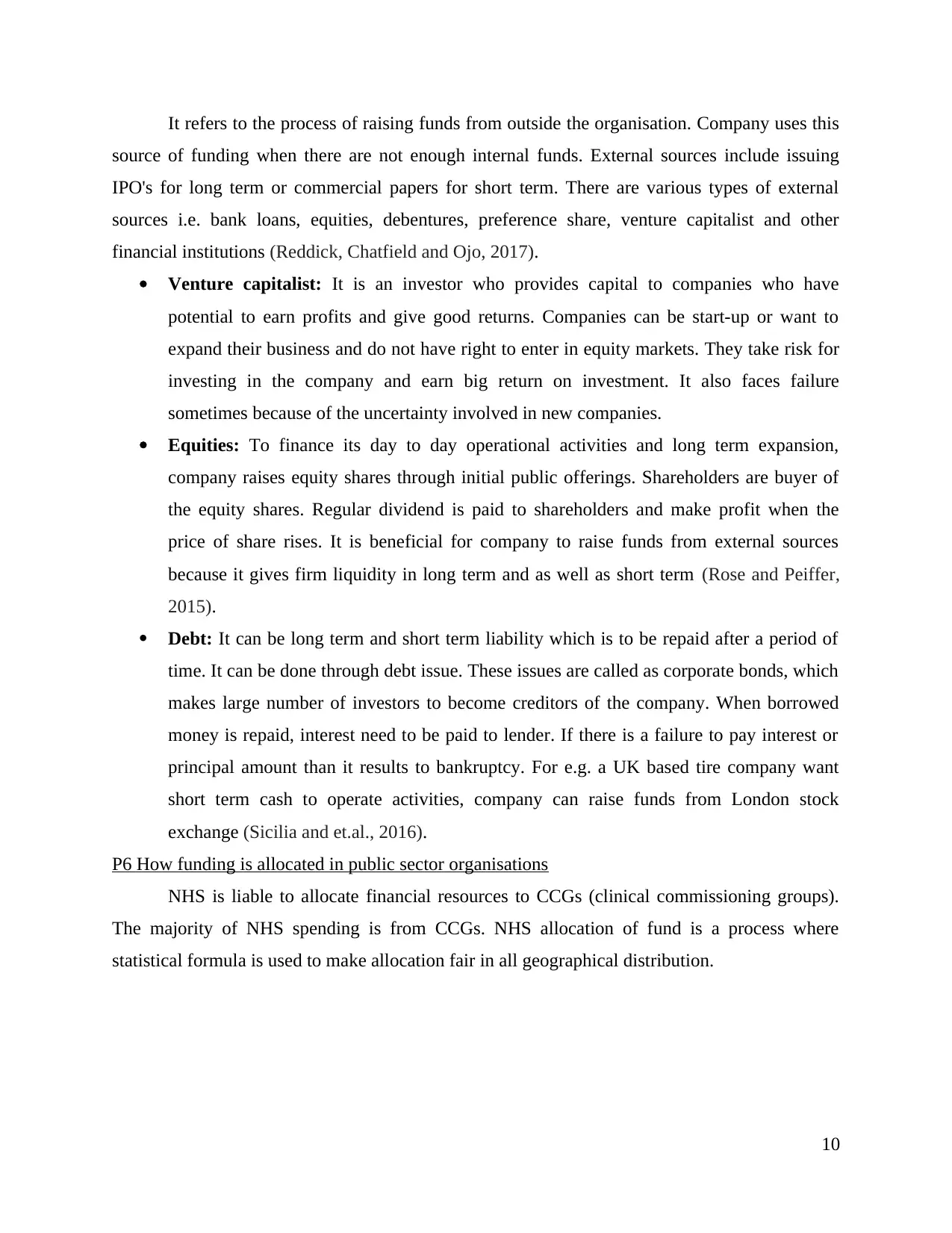
It refers to the process of raising funds from outside the organisation. Company uses this
source of funding when there are not enough internal funds. External sources include issuing
IPO's for long term or commercial papers for short term. There are various types of external
sources i.e. bank loans, equities, debentures, preference share, venture capitalist and other
financial institutions (Reddick, Chatfield and Ojo, 2017).
Venture capitalist: It is an investor who provides capital to companies who have
potential to earn profits and give good returns. Companies can be start-up or want to
expand their business and do not have right to enter in equity markets. They take risk for
investing in the company and earn big return on investment. It also faces failure
sometimes because of the uncertainty involved in new companies.
Equities: To finance its day to day operational activities and long term expansion,
company raises equity shares through initial public offerings. Shareholders are buyer of
the equity shares. Regular dividend is paid to shareholders and make profit when the
price of share rises. It is beneficial for company to raise funds from external sources
because it gives firm liquidity in long term and as well as short term (Rose and Peiffer,
2015).
Debt: It can be long term and short term liability which is to be repaid after a period of
time. It can be done through debt issue. These issues are called as corporate bonds, which
makes large number of investors to become creditors of the company. When borrowed
money is repaid, interest need to be paid to lender. If there is a failure to pay interest or
principal amount than it results to bankruptcy. For e.g. a UK based tire company want
short term cash to operate activities, company can raise funds from London stock
exchange (Sicilia and et.al., 2016).
P6 How funding is allocated in public sector organisations
NHS is liable to allocate financial resources to CCGs (clinical commissioning groups).
The majority of NHS spending is from CCGs. NHS allocation of fund is a process where
statistical formula is used to make allocation fair in all geographical distribution.
10
source of funding when there are not enough internal funds. External sources include issuing
IPO's for long term or commercial papers for short term. There are various types of external
sources i.e. bank loans, equities, debentures, preference share, venture capitalist and other
financial institutions (Reddick, Chatfield and Ojo, 2017).
Venture capitalist: It is an investor who provides capital to companies who have
potential to earn profits and give good returns. Companies can be start-up or want to
expand their business and do not have right to enter in equity markets. They take risk for
investing in the company and earn big return on investment. It also faces failure
sometimes because of the uncertainty involved in new companies.
Equities: To finance its day to day operational activities and long term expansion,
company raises equity shares through initial public offerings. Shareholders are buyer of
the equity shares. Regular dividend is paid to shareholders and make profit when the
price of share rises. It is beneficial for company to raise funds from external sources
because it gives firm liquidity in long term and as well as short term (Rose and Peiffer,
2015).
Debt: It can be long term and short term liability which is to be repaid after a period of
time. It can be done through debt issue. These issues are called as corporate bonds, which
makes large number of investors to become creditors of the company. When borrowed
money is repaid, interest need to be paid to lender. If there is a failure to pay interest or
principal amount than it results to bankruptcy. For e.g. a UK based tire company want
short term cash to operate activities, company can raise funds from London stock
exchange (Sicilia and et.al., 2016).
P6 How funding is allocated in public sector organisations
NHS is liable to allocate financial resources to CCGs (clinical commissioning groups).
The majority of NHS spending is from CCGs. NHS allocation of fund is a process where
statistical formula is used to make allocation fair in all geographical distribution.
10
You're viewing a preview
Unlock full access by subscribing today!
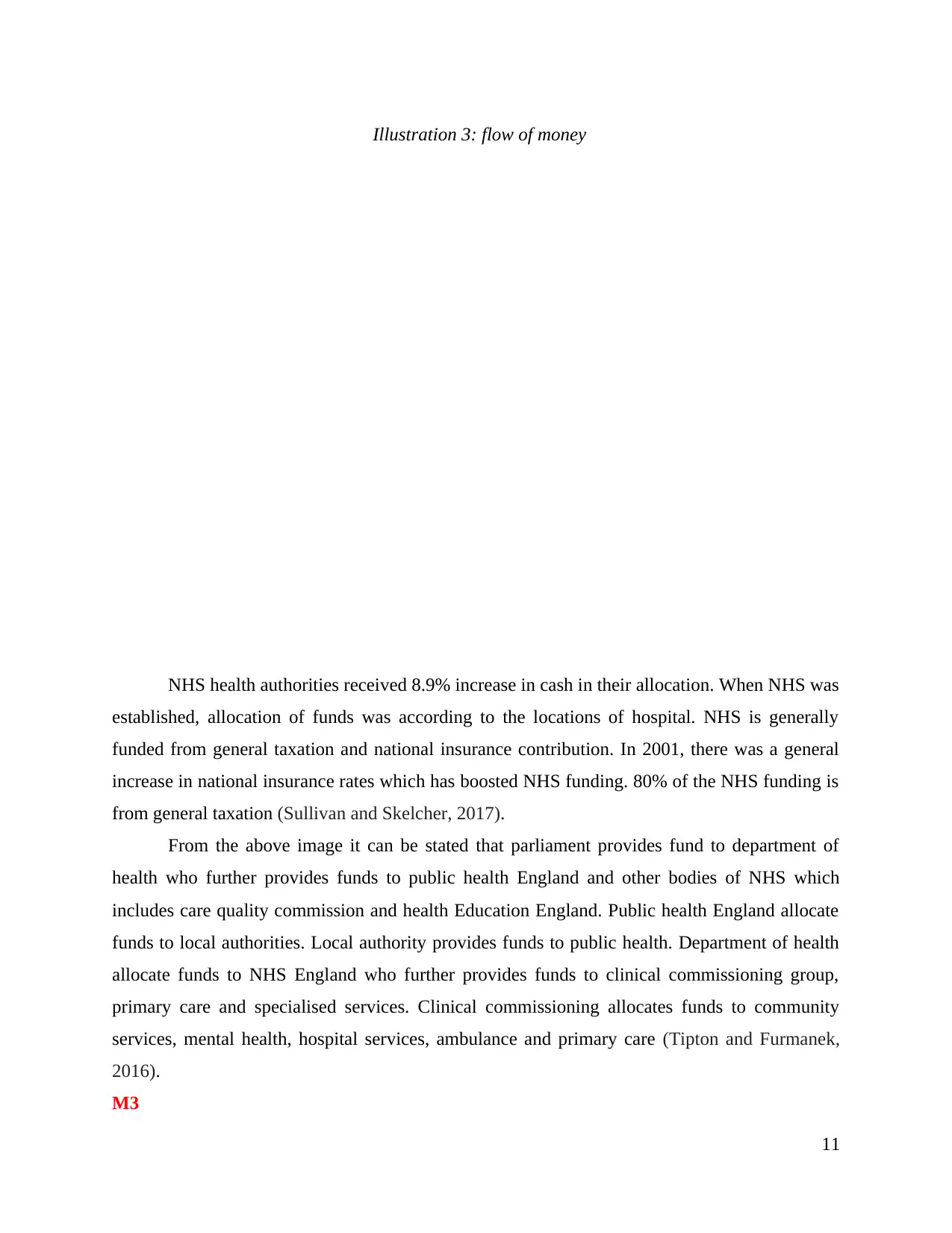
NHS health authorities received 8.9% increase in cash in their allocation. When NHS was
established, allocation of funds was according to the locations of hospital. NHS is generally
funded from general taxation and national insurance contribution. In 2001, there was a general
increase in national insurance rates which has boosted NHS funding. 80% of the NHS funding is
from general taxation (Sullivan and Skelcher, 2017).
From the above image it can be stated that parliament provides fund to department of
health who further provides funds to public health England and other bodies of NHS which
includes care quality commission and health Education England. Public health England allocate
funds to local authorities. Local authority provides funds to public health. Department of health
allocate funds to NHS England who further provides funds to clinical commissioning group,
primary care and specialised services. Clinical commissioning allocates funds to community
services, mental health, hospital services, ambulance and primary care (Tipton and Furmanek,
2016).
M3
11
Illustration 3: flow of money
established, allocation of funds was according to the locations of hospital. NHS is generally
funded from general taxation and national insurance contribution. In 2001, there was a general
increase in national insurance rates which has boosted NHS funding. 80% of the NHS funding is
from general taxation (Sullivan and Skelcher, 2017).
From the above image it can be stated that parliament provides fund to department of
health who further provides funds to public health England and other bodies of NHS which
includes care quality commission and health Education England. Public health England allocate
funds to local authorities. Local authority provides funds to public health. Department of health
allocate funds to NHS England who further provides funds to clinical commissioning group,
primary care and specialised services. Clinical commissioning allocates funds to community
services, mental health, hospital services, ambulance and primary care (Tipton and Furmanek,
2016).
M3
11
Illustration 3: flow of money
Paraphrase This Document
Need a fresh take? Get an instant paraphrase of this document with our AI Paraphraser
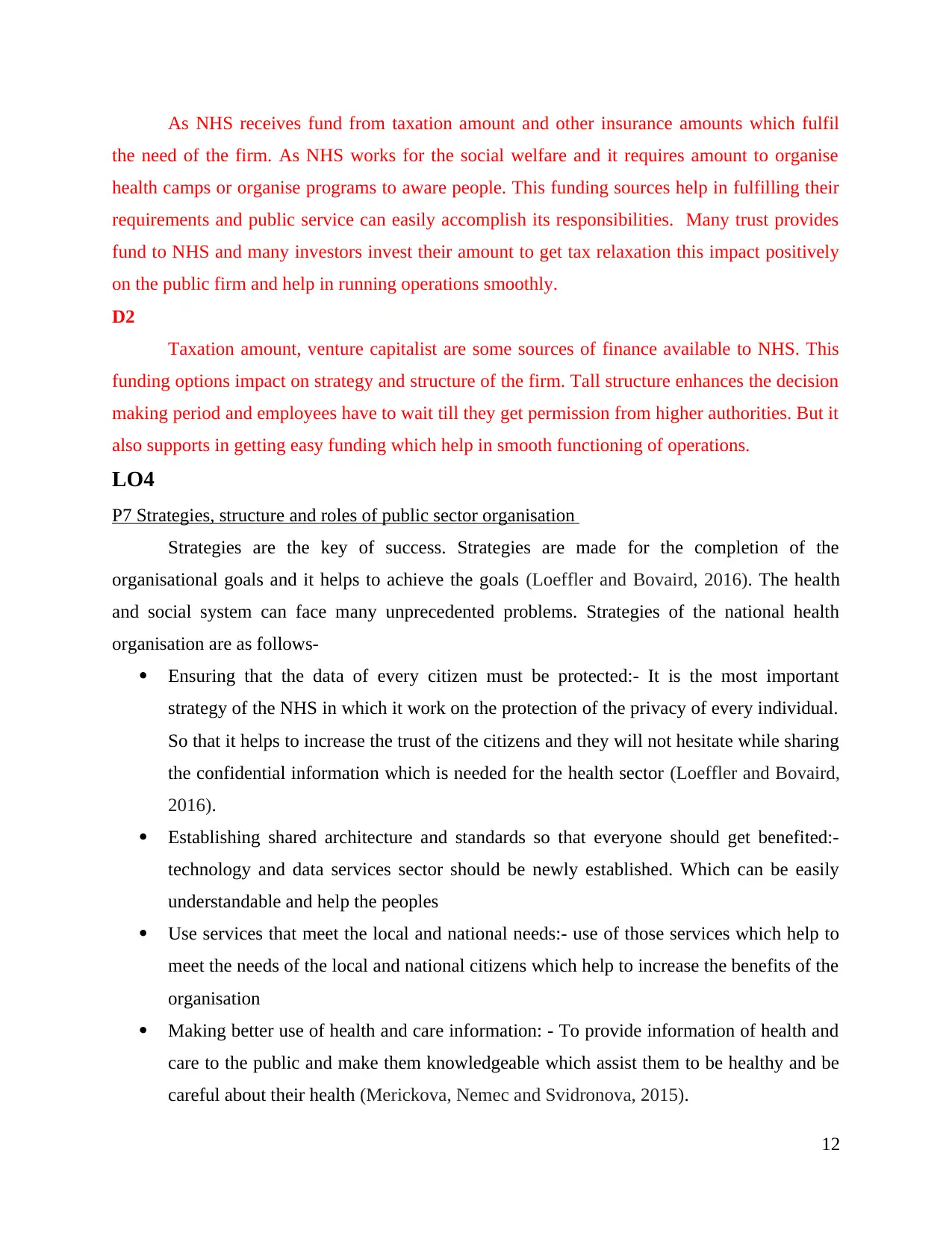
As NHS receives fund from taxation amount and other insurance amounts which fulfil
the need of the firm. As NHS works for the social welfare and it requires amount to organise
health camps or organise programs to aware people. This funding sources help in fulfilling their
requirements and public service can easily accomplish its responsibilities. Many trust provides
fund to NHS and many investors invest their amount to get tax relaxation this impact positively
on the public firm and help in running operations smoothly.
D2
Taxation amount, venture capitalist are some sources of finance available to NHS. This
funding options impact on strategy and structure of the firm. Tall structure enhances the decision
making period and employees have to wait till they get permission from higher authorities. But it
also supports in getting easy funding which help in smooth functioning of operations.
LO4
P7 Strategies, structure and roles of public sector organisation
Strategies are the key of success. Strategies are made for the completion of the
organisational goals and it helps to achieve the goals (Loeffler and Bovaird, 2016). The health
and social system can face many unprecedented problems. Strategies of the national health
organisation are as follows-
Ensuring that the data of every citizen must be protected:- It is the most important
strategy of the NHS in which it work on the protection of the privacy of every individual.
So that it helps to increase the trust of the citizens and they will not hesitate while sharing
the confidential information which is needed for the health sector (Loeffler and Bovaird,
2016).
Establishing shared architecture and standards so that everyone should get benefited:-
technology and data services sector should be newly established. Which can be easily
understandable and help the peoples
Use services that meet the local and national needs:- use of those services which help to
meet the needs of the local and national citizens which help to increase the benefits of the
organisation
Making better use of health and care information: - To provide information of health and
care to the public and make them knowledgeable which assist them to be healthy and be
careful about their health (Merickova, Nemec and Svidronova, 2015).
12
the need of the firm. As NHS works for the social welfare and it requires amount to organise
health camps or organise programs to aware people. This funding sources help in fulfilling their
requirements and public service can easily accomplish its responsibilities. Many trust provides
fund to NHS and many investors invest their amount to get tax relaxation this impact positively
on the public firm and help in running operations smoothly.
D2
Taxation amount, venture capitalist are some sources of finance available to NHS. This
funding options impact on strategy and structure of the firm. Tall structure enhances the decision
making period and employees have to wait till they get permission from higher authorities. But it
also supports in getting easy funding which help in smooth functioning of operations.
LO4
P7 Strategies, structure and roles of public sector organisation
Strategies are the key of success. Strategies are made for the completion of the
organisational goals and it helps to achieve the goals (Loeffler and Bovaird, 2016). The health
and social system can face many unprecedented problems. Strategies of the national health
organisation are as follows-
Ensuring that the data of every citizen must be protected:- It is the most important
strategy of the NHS in which it work on the protection of the privacy of every individual.
So that it helps to increase the trust of the citizens and they will not hesitate while sharing
the confidential information which is needed for the health sector (Loeffler and Bovaird,
2016).
Establishing shared architecture and standards so that everyone should get benefited:-
technology and data services sector should be newly established. Which can be easily
understandable and help the peoples
Use services that meet the local and national needs:- use of those services which help to
meet the needs of the local and national citizens which help to increase the benefits of the
organisation
Making better use of health and care information: - To provide information of health and
care to the public and make them knowledgeable which assist them to be healthy and be
careful about their health (Merickova, Nemec and Svidronova, 2015).
12
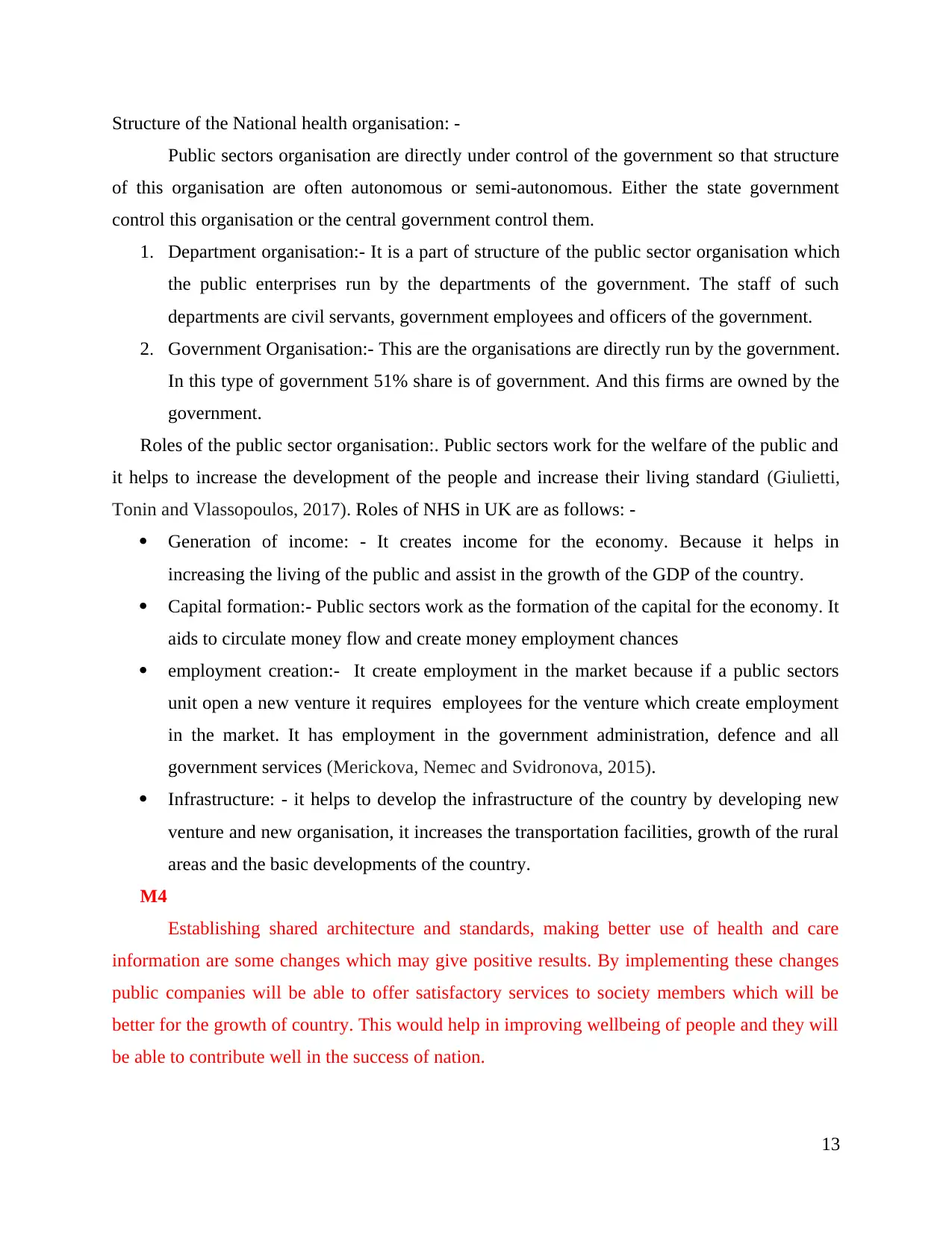
Structure of the National health organisation: -
Public sectors organisation are directly under control of the government so that structure
of this organisation are often autonomous or semi-autonomous. Either the state government
control this organisation or the central government control them.
1. Department organisation:- It is a part of structure of the public sector organisation which
the public enterprises run by the departments of the government. The staff of such
departments are civil servants, government employees and officers of the government.
2. Government Organisation:- This are the organisations are directly run by the government.
In this type of government 51% share is of government. And this firms are owned by the
government.
Roles of the public sector organisation:. Public sectors work for the welfare of the public and
it helps to increase the development of the people and increase their living standard (Giulietti,
Tonin and Vlassopoulos, 2017). Roles of NHS in UK are as follows: -
Generation of income: - It creates income for the economy. Because it helps in
increasing the living of the public and assist in the growth of the GDP of the country.
Capital formation:- Public sectors work as the formation of the capital for the economy. It
aids to circulate money flow and create money employment chances
employment creation:- It create employment in the market because if a public sectors
unit open a new venture it requires employees for the venture which create employment
in the market. It has employment in the government administration, defence and all
government services (Merickova, Nemec and Svidronova, 2015).
Infrastructure: - it helps to develop the infrastructure of the country by developing new
venture and new organisation, it increases the transportation facilities, growth of the rural
areas and the basic developments of the country.
M4
Establishing shared architecture and standards, making better use of health and care
information are some changes which may give positive results. By implementing these changes
public companies will be able to offer satisfactory services to society members which will be
better for the growth of country. This would help in improving wellbeing of people and they will
be able to contribute well in the success of nation.
13
Public sectors organisation are directly under control of the government so that structure
of this organisation are often autonomous or semi-autonomous. Either the state government
control this organisation or the central government control them.
1. Department organisation:- It is a part of structure of the public sector organisation which
the public enterprises run by the departments of the government. The staff of such
departments are civil servants, government employees and officers of the government.
2. Government Organisation:- This are the organisations are directly run by the government.
In this type of government 51% share is of government. And this firms are owned by the
government.
Roles of the public sector organisation:. Public sectors work for the welfare of the public and
it helps to increase the development of the people and increase their living standard (Giulietti,
Tonin and Vlassopoulos, 2017). Roles of NHS in UK are as follows: -
Generation of income: - It creates income for the economy. Because it helps in
increasing the living of the public and assist in the growth of the GDP of the country.
Capital formation:- Public sectors work as the formation of the capital for the economy. It
aids to circulate money flow and create money employment chances
employment creation:- It create employment in the market because if a public sectors
unit open a new venture it requires employees for the venture which create employment
in the market. It has employment in the government administration, defence and all
government services (Merickova, Nemec and Svidronova, 2015).
Infrastructure: - it helps to develop the infrastructure of the country by developing new
venture and new organisation, it increases the transportation facilities, growth of the rural
areas and the basic developments of the country.
M4
Establishing shared architecture and standards, making better use of health and care
information are some changes which may give positive results. By implementing these changes
public companies will be able to offer satisfactory services to society members which will be
better for the growth of country. This would help in improving wellbeing of people and they will
be able to contribute well in the success of nation.
13
You're viewing a preview
Unlock full access by subscribing today!
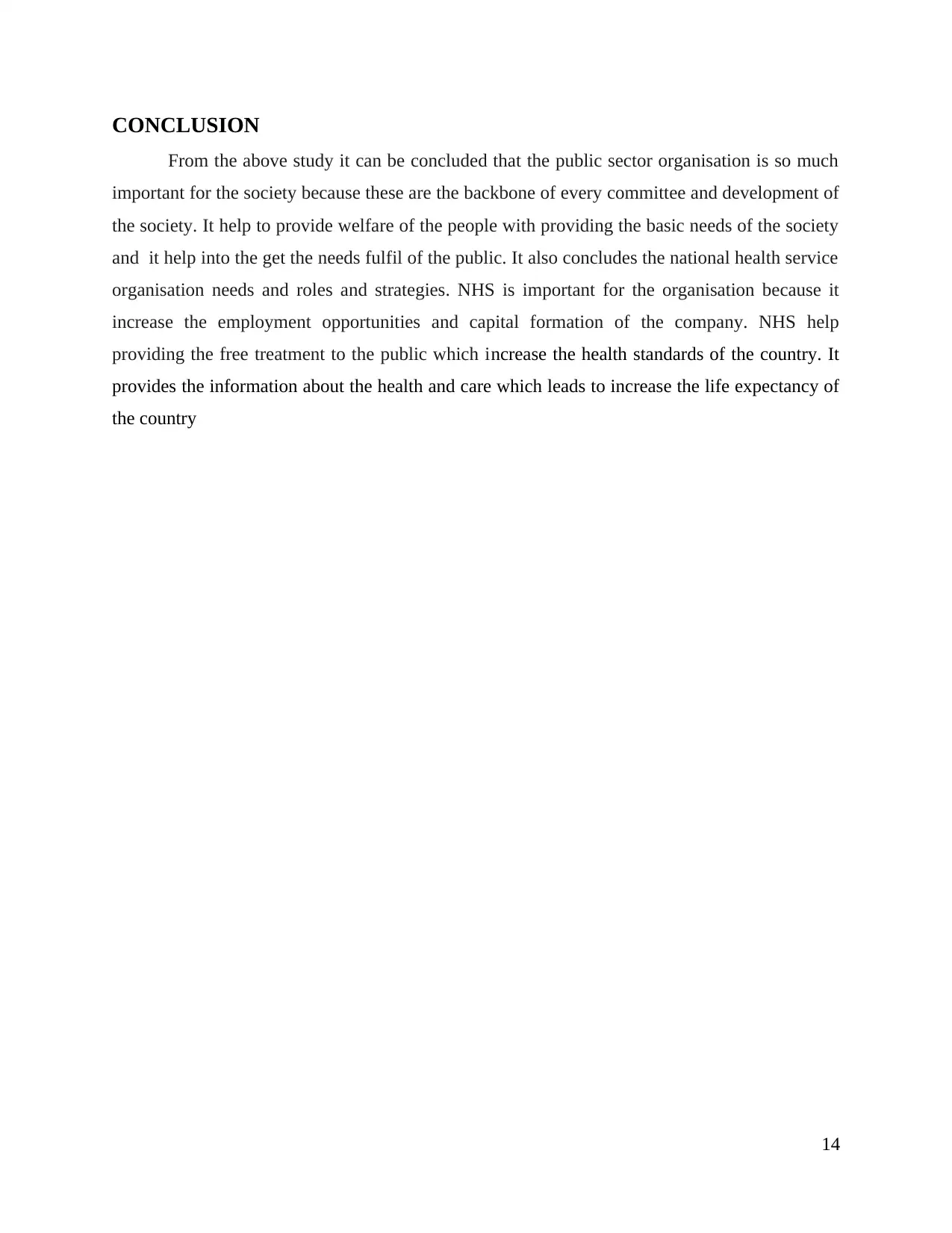
CONCLUSION
From the above study it can be concluded that the public sector organisation is so much
important for the society because these are the backbone of every committee and development of
the society. It help to provide welfare of the people with providing the basic needs of the society
and it help into the get the needs fulfil of the public. It also concludes the national health service
organisation needs and roles and strategies. NHS is important for the organisation because it
increase the employment opportunities and capital formation of the company. NHS help
providing the free treatment to the public which increase the health standards of the country. It
provides the information about the health and care which leads to increase the life expectancy of
the country
14
From the above study it can be concluded that the public sector organisation is so much
important for the society because these are the backbone of every committee and development of
the society. It help to provide welfare of the people with providing the basic needs of the society
and it help into the get the needs fulfil of the public. It also concludes the national health service
organisation needs and roles and strategies. NHS is important for the organisation because it
increase the employment opportunities and capital formation of the company. NHS help
providing the free treatment to the public which increase the health standards of the country. It
provides the information about the health and care which leads to increase the life expectancy of
the country
14
Paraphrase This Document
Need a fresh take? Get an instant paraphrase of this document with our AI Paraphraser
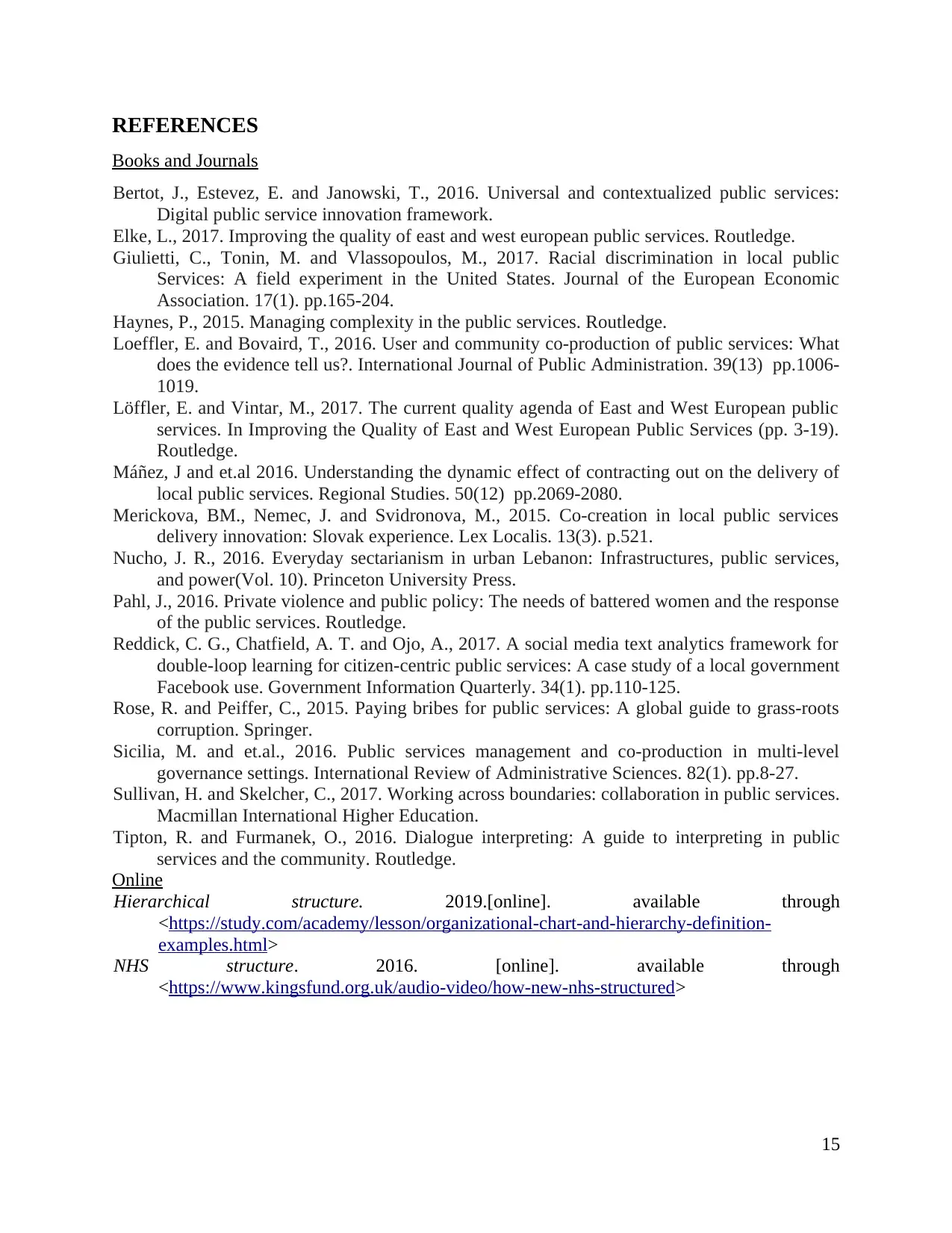
REFERENCES
Books and Journals
Bertot, J., Estevez, E. and Janowski, T., 2016. Universal and contextualized public services:
Digital public service innovation framework.
Elke, L., 2017. Improving the quality of east and west european public services. Routledge.
Giulietti, C., Tonin, M. and Vlassopoulos, M., 2017. Racial discrimination in local public
Services: A field experiment in the United States. Journal of the European Economic
Association. 17(1). pp.165-204.
Haynes, P., 2015. Managing complexity in the public services. Routledge.
Loeffler, E. and Bovaird, T., 2016. User and community co-production of public services: What
does the evidence tell us?. International Journal of Public Administration. 39(13) pp.1006-
1019.
Löffler, E. and Vintar, M., 2017. The current quality agenda of East and West European public
services. In Improving the Quality of East and West European Public Services (pp. 3-19).
Routledge.
Máñez, J and et.al 2016. Understanding the dynamic effect of contracting out on the delivery of
local public services. Regional Studies. 50(12) pp.2069-2080.
Merickova, BM., Nemec, J. and Svidronova, M., 2015. Co-creation in local public services
delivery innovation: Slovak experience. Lex Localis. 13(3). p.521.
Nucho, J. R., 2016. Everyday sectarianism in urban Lebanon: Infrastructures, public services,
and power(Vol. 10). Princeton University Press.
Pahl, J., 2016. Private violence and public policy: The needs of battered women and the response
of the public services. Routledge.
Reddick, C. G., Chatfield, A. T. and Ojo, A., 2017. A social media text analytics framework for
double-loop learning for citizen-centric public services: A case study of a local government
Facebook use. Government Information Quarterly. 34(1). pp.110-125.
Rose, R. and Peiffer, C., 2015. Paying bribes for public services: A global guide to grass-roots
corruption. Springer.
Sicilia, M. and et.al., 2016. Public services management and co-production in multi-level
governance settings. International Review of Administrative Sciences. 82(1). pp.8-27.
Sullivan, H. and Skelcher, C., 2017. Working across boundaries: collaboration in public services.
Macmillan International Higher Education.
Tipton, R. and Furmanek, O., 2016. Dialogue interpreting: A guide to interpreting in public
services and the community. Routledge.
Online
Hierarchical structure. 2019.[online]. available through
<https://study.com/academy/lesson/organizational-chart-and-hierarchy-definition-
examples.html>
NHS structure. 2016. [online]. available through
<https://www.kingsfund.org.uk/audio-video/how-new-nhs-structured>
15
Books and Journals
Bertot, J., Estevez, E. and Janowski, T., 2016. Universal and contextualized public services:
Digital public service innovation framework.
Elke, L., 2017. Improving the quality of east and west european public services. Routledge.
Giulietti, C., Tonin, M. and Vlassopoulos, M., 2017. Racial discrimination in local public
Services: A field experiment in the United States. Journal of the European Economic
Association. 17(1). pp.165-204.
Haynes, P., 2015. Managing complexity in the public services. Routledge.
Loeffler, E. and Bovaird, T., 2016. User and community co-production of public services: What
does the evidence tell us?. International Journal of Public Administration. 39(13) pp.1006-
1019.
Löffler, E. and Vintar, M., 2017. The current quality agenda of East and West European public
services. In Improving the Quality of East and West European Public Services (pp. 3-19).
Routledge.
Máñez, J and et.al 2016. Understanding the dynamic effect of contracting out on the delivery of
local public services. Regional Studies. 50(12) pp.2069-2080.
Merickova, BM., Nemec, J. and Svidronova, M., 2015. Co-creation in local public services
delivery innovation: Slovak experience. Lex Localis. 13(3). p.521.
Nucho, J. R., 2016. Everyday sectarianism in urban Lebanon: Infrastructures, public services,
and power(Vol. 10). Princeton University Press.
Pahl, J., 2016. Private violence and public policy: The needs of battered women and the response
of the public services. Routledge.
Reddick, C. G., Chatfield, A. T. and Ojo, A., 2017. A social media text analytics framework for
double-loop learning for citizen-centric public services: A case study of a local government
Facebook use. Government Information Quarterly. 34(1). pp.110-125.
Rose, R. and Peiffer, C., 2015. Paying bribes for public services: A global guide to grass-roots
corruption. Springer.
Sicilia, M. and et.al., 2016. Public services management and co-production in multi-level
governance settings. International Review of Administrative Sciences. 82(1). pp.8-27.
Sullivan, H. and Skelcher, C., 2017. Working across boundaries: collaboration in public services.
Macmillan International Higher Education.
Tipton, R. and Furmanek, O., 2016. Dialogue interpreting: A guide to interpreting in public
services and the community. Routledge.
Online
Hierarchical structure. 2019.[online]. available through
<https://study.com/academy/lesson/organizational-chart-and-hierarchy-definition-
examples.html>
NHS structure. 2016. [online]. available through
<https://www.kingsfund.org.uk/audio-video/how-new-nhs-structured>
15
1 out of 17
Related Documents
Your All-in-One AI-Powered Toolkit for Academic Success.
+13062052269
info@desklib.com
Available 24*7 on WhatsApp / Email
![[object Object]](/_next/static/media/star-bottom.7253800d.svg)
Unlock your academic potential
© 2024 | Zucol Services PVT LTD | All rights reserved.





